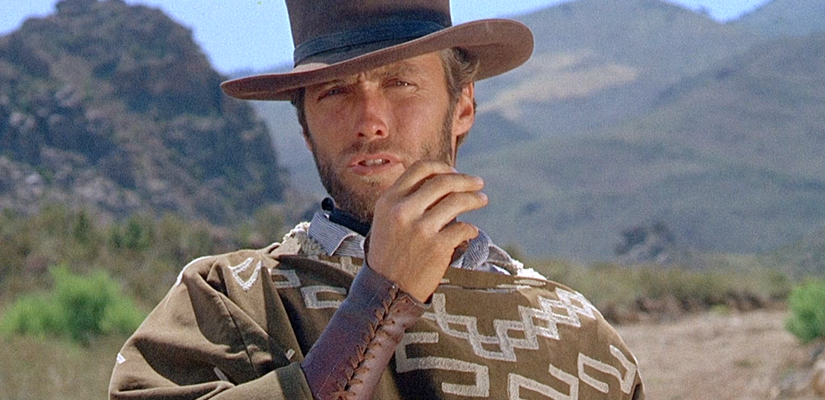A vast empty Western landscape. The camera pans across it. Then the shot slides onto a sunburned, desperate face. The long shot has become a closeup without a cut, revealing that the landscape was not empty but occupied by a desperado very close to us.
In these opening frames, Sergio Leone established a rule that he follows throughout “The Good, the Bad and the Ugly.” The rule is that the ability to see is limited by the sides of the frame. At important moments in the film, what the camera cannot see, the characters cannot see, and that gives Leone the freedom to surprise us with entrances that cannot be explained by the practical geography of his shots.
There is a moment, for example, when men do not notice a vast encampment of the Union Army until they stumble upon it. And a moment in a cemetery when a man materializes out of thin air even though he should have been visible for a mile. And the way men walk down a street in full view and nobody is able to shoot them, maybe because they are not in the same frame with them.
Leone cares not at all about the practical or the plausible, and builds his great film on the rubbish of Western movie cliches, using style to elevate dreck into art. When the movie opened in America in late 1967, not long after its predecessors “A Fistful of Dollars” (1964) and “For a Few Dollars More” (1965), audiences knew they liked it, but did they know why?
I saw it sitting in the front row of the balcony of the Oriental Theatre, whose vast wide screen was ideal for Leone’s operatic compositions. I responded strongly, but had been a movie critic less than a year, and did not always have the wisdom to value instinct over prudence. Looking up my old review, I see I described a four-star movie but only gave it three stars, perhaps because it was a “spaghetti Western” and so could not be art.

But art it is, summoned out of the imagination of Leone and painted on the wide screen so vividly that we forget what marginal productions these films were–that Clint Eastwood was a Hollywood reject, that budgetary restraints ($200,000 for “Fistful”) caused gaping continuity errors, that there wasn’t a lot of dialogue because it was easier to shoot silent and fill the soundtrack with music and effects. There was even a pathetic attempt to make the films seem more American; I learn from the critic Glenn Erickson that Leone was credited as “Bob Robertson” in the early prints of “Fistful,” and composer Ennio Morricone, whose lonely, mournful scores are inseparable from the films, was “Dan Savio.” Even Eastwood’s character, the famous Man With No Name, was an invention of the publicists; he was called Joe in the first movie, Manco in the second, and Blondie in the third.
Perhaps it is the subtly foreign flavor of the spaghetti trilogy, and especially the masterpiece “The Good, the Bad and the Ugly,” that suggests the films come from a different universe than traditional Westerns. Instead of tame Hollywood extras from central casting, we get locals who must have been hired near the Spanish locations–men who look long-weathered by work and the sun. Consider the legless beggar who uses his arms to propel himself into a saloon, shouting, “Hand me down a whiskey!”

John Ford made Monument Valley the home turf of his Western characters, and he made great films there, but there is something new and strange about Leone’s menacing Spanish vistas. We haven’t seen these deserts before. John Wayne has never been here. Leone’s stories are a heightened dream in which everything is bigger, starker, more brutal, more dramatic, than life.
Leone tells the story more with pictures than words. Examine the masterful scene in the cemetery. A fortune in gold is said to be buried in one of the graves, and three men have assembled, all hoping to get it. The actors are Clint Eastwood (the Good), Lee Van Cleef (the Bad), and Eli Wallach (the Ugly). Each man points a pistol at the other. If one shoots, they all shoot, and all die. Unless two decide to shoot the third man before he can shoot either one of them. But which two, and which third?

Leone draws this scene out beyond all reason, beginning in long shot and working in to closeups of firearms, faces, eyes, and lots of sweat and flies. He seems to be testing himself, to see how long he can maintain the suspense. Or is it even suspense, really? It may be entirely an exercise in style, a deliberate manipulation by the director, intended to draw attention to itself. If you savor the boldness with which Leone flirts with parody, you understand his method. This is not a story, but a celebration of bold gestures.
Eastwood, 34 when he first worked with Leone, already carried unquestioned authority. Much is made of the fact that he came from television, that he starred in “Rawhide,” that in those days it was thought that a movie audience wouldn’t pay to see an actor it could watch for free. Eastwood overcame that jinx, but not any actor could ha




